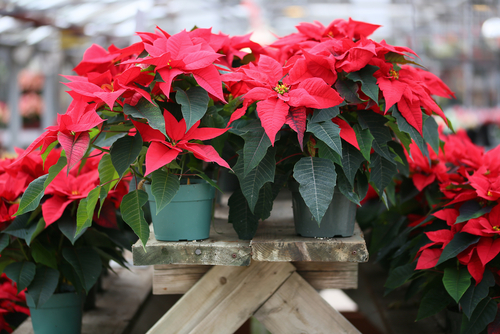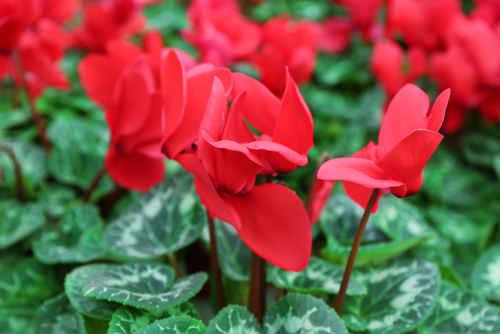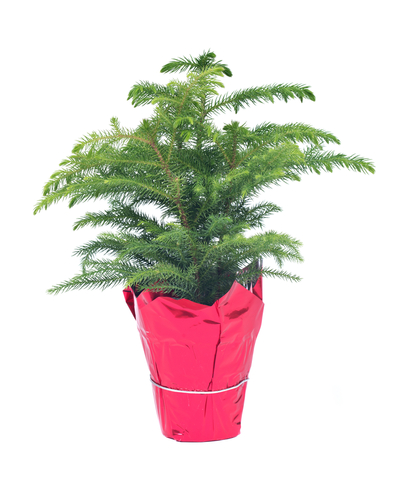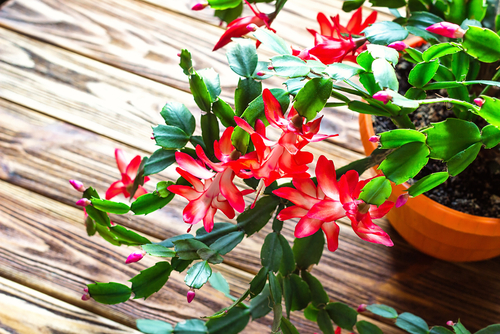Like many, many landscaping firms, a big part of John Mini's business is creating lovely holiday displays. Of course, the most popular holiday plant is the poinsettia; other popular holiday plants include Cyclamen, Norfolk Island Pine and the Christmas (actually Thanksgiving) Cactus. Here are some tips for keeping your plants healthy for the holidays and beyond.
Poinsettias (Euphorbia pulcherimma)

Poinsettias are so popular, they may be the most widely grown potted plant. Native to dry forests in Mexico, they are actually close relatives of garden euphorbias and the African crown of thorns. As many readers know, the red “petals” are not flowers but modified leaves. Two more interesting facts: 1) the multiple bracts are actually the result of a phytoplasma infection (a phytoplasma is a bacterial parasite that causes distortion; this is probably the only known useful phytoplasma), and; (2) contrary to popular belief, they are not very toxic to children or pets--they just taste really bad.
Poinsettias prefer good light and moderate moisture. While they are not jungle plants, they do need more water than other euphorbias and must never dry out completely. As the red bracts fade, you will be left with a leggy shrub that can be pruned to shape. Some will set about to get the plant to “rebloom” again the following winter. The key here is day length. To set bud, poinsettias will need sunny days, and about twelve hours of darkness starting in late fall. This is why you almost never see poinsettias rebloom in office settings—the lights are kept on at night. While your poinsettia will not be as compact as when you acquired it, getting one to rebloom can be a rewarding project.
Florist's Cyclamen (cultivars of Cyclamen persicum)

Many retailers that sell poinsettias often carry the florist's cyclamens. These are cultivars of a Mediterranean plant in the primrose family. Cyclamens grow in loose rosettes, often with spotted leaves and upright flowers that come in a variety of colors. Unlike poinsettias, cyclamen tubers really are poisonous, so keep away from young children and dogs.
In nature, Cyclamen persicum goes dormant in summer and regrows in fall. They naturally flower in winter. Three keys: 1) Cyclamens like it bright, but on the cool side. Keep away from radiators or other heat sources; (2) Water freely when in leaf, taper off in late winter/early spring. In summer, occasionally tickle the pot with water; (3) Water more freely when the plant starts to leaf out in late summer. A plant food with a high phosphorus (middle) number will promote more blooms.
Norfolk Island Pine (Araucaria heterophylla)

These tropical conifers (but not true pines) are often sold as houseplants or as live indoor Christmas trees. Araucarias are ancient plants, with the genus dating back to the Jurassic, before the breakup of Gondwanaland into the southern continents. Some paleontologists suggest they were an important food source for sauropod dinosaurs! The Norfolk Island pine may be endemic to one island, but it is now grown in many mild regions of the world. In the ground, they can grow quite tall, sometimes to 150 feet. (Although some municipalities forbid them because they can be damaged by lightning and high winds.) Like most tropical conifers, Norfolks are not cold hardy.
As a houseplant, they can do well if one has some good light and space; specimens of 5-6 feet are not uncommon. Norfolks enjoy bright light and moderate watering--what they cannot tolerate is hot, dry air. Some growers like to leave multiple stems to get a fuller look. If you have a porch or deck, they enjoy spending the summer outside. But do not be in a rush to repot--you want to slow it down indoors.
Holiday Cacti (Schlumbergera species and cultivars)

The most common holiday cactus is the Thanksgiving cactus (Schlumbergera truncata). This is the holiday cactus you will see for sale almost anywhere plants are sold. While the parent species has red flowers, cultivars now come in a variety of colors. The true Christmas cactus (Schlumbergera x buckleyi) is an old Victorian hybrid of a related species that blooms later; hence their respective common names. Both parent species are native to coastal Brazil, where they grow as epiphytes in tree forks. The rarer Christmas cactus is a more pendant plant with more “regular” (symmetrical) magenta flowers. Because the Thanksgiving cactus blooms longer and tolerates lower light, it has become a much more popular plant. In both plants, individual flowers last only one or two days.
Holiday cacti are not difficult to grow. Do not be in a rush to give your 4” plant a big pot; as epiphytes, they should be grown in smaller pots with a loose mix. Both are great plants for hanging baskets (orchid baskets work quite well for these guys). The Thanksgiving cactus tolerates moderate light while the Christmas cactus prefers brighter conditions. However, neither plant should be grown in full sun like a terrestrial cactus. Both of these cacti do fine with moderate watering. As with poinsettias, the one necessary condition is a period of long, dark nights beginning in early October. Contrary to what one might have heard, it is not a good practice to withhold watering before the blooming period. Follow these simple steps, and you will be rewarded with lots of holiday blooms. These cacti are tough, long-lived plants—some plants in cultivation are known to be over 100 years old.
Happy holidays!